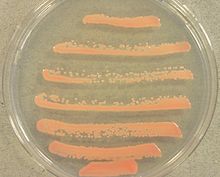Rhodotorula glutinis
| Rhodotorula glutinis | |
|---|---|
 |
|
| Scientific classification | |
| Kingdom: | Fungi |
| Division: | Basidiomycota |
| Class: | Microbotryomycetes |
| Order: | Sporidiobolales |
| Genus: | Rhodotorula |
| Species: | R. glutinis |
| Binomial name | |
|
Rhodotorula glutinis (Fresen.) F.C. Harrison (1928) |
|
| Synonyms | |
|
|
Rhodotorula glutinis (Fresenius) F.C. Harrison is the type species of the genus Rhodotorula, a basidiomycetous genus of pink yeasts which contains 370 species. Heterogeneity of the genus has made its classification difficult with five varieties having been recognized, however as of 2011 all are considered to represent a single taxon. The fungus is a common colonist of animals, foods and environmental materials. It can cause opportunistic infections, notably blood infection in the setting of significant underlying disease. It has been used industrially in the production of carotenoid pigments and as a biocontrol agent for post-harvest spoilage diseases of fruits.
Rhodotorula glutinis is the type species of the genus Rhodotorula, a basidiomycetous genus of pink yeasts, which contains 370 species. Heterogeneity of the genus has made its classification difficult with five varieties having been recognized, however as of 2011 all have been considered to represent a single taxon.
R. glutinis is an aerobic yeast characterized by pink, smooth colonies with a moist appearance. Reproduction is typically by multipolar budding although pseudohyphae are occasionally produced. Sexual reproduction is by basidiospores arising from a teliospore developed from a mycelial clamp connection. A distinguishing feature of the species and its close relatives are the intense yellow and red pigments produced during growth on most substrates.
It normally grows at 37 °C at a rapid rate, and requires a minimum water activity of 0.92, pH of 2.2, and organic acids or HCl. Growth is inhibited by 100 mg/kg or less of benzoic acid or sorbic acid and a pH of 4 or above. The fungus is unable to grow on malt acetic agar or MY50G medium. At maturity, the cells reach a diameter of 3-5 µm and are round, oval, or elongate in shape, aggregating as mucoid colonies. Carbohydrates in the cell include glucose, fucose, galactose, and mannose.R. glutinis is heat resistant, an uncommon feature in yeasts without spores, tolerating 62.5 °C (144.5 °F) for 10 minutes. R. glutinis is closely related to Rhodotorula mucilaginosa, differing only in their ability to use nitrate as a nitrogen source, which R. glutinis cannot assimilate. Both species are incapable of fermentation and assimilation of Myo-Inositol and D-glucoronate.
...
Wikipedia
